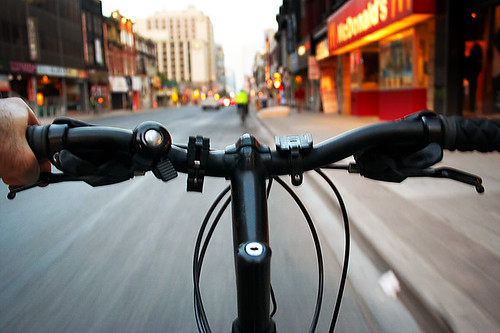
The City of Toronto Official Plan envisions a city where active transportation helps to relieve congestion and improve air quality. Yet, right now less than 2 per cent of the City of Toronto Transportation budget is dedicated to walking and cycling infrastructure.
Tomorrow, Thursday March 6th, the City of Toronto’s budget committee will meet to wrap up the 2008 Operating Budget. The Operating Budget pays for the staff that runs programs and services. For several years now cycling activists have been trying to get increases in this area without success. Although we welcome the 2008 capital budget increase in transportation services from $3.0 million to $5.5 million for cycling infrastructure (needed to install the substantial increased amount of 50 km of on-street bike lanes scheduled for this year) it is now time to ask that the cycling safety, education and promotion programs also receive a similar much-needed boost.
Martin Koob of biketoronto.ca has posted a succinct summary. It includes an outline of the Toronto Coalition for Active Transportation’s (TCAT) bike-related recommendations (Read TCAT’s full letter to the Budget Committee).
They asked council to:
- Double the current funding dedicated to cycling promotion, safety and education staff and programs — like Bike Month and Kids CAN-Bike Camps — from $164,000 to $328,000 in the City Planning operating budget.
- Fund a full-time trails and pathways planner to coordinate the planning, consultation, construction and maintenance of bikeway network infrastructure projects in Toronto’s parks — approximately $80,000 in the Parks, Forestry and Recreation operating budget.
As a member of the Toronto Cycling Advisory Committee, I wrote a letter in support of increasing funding for Kid’s CAN-BIKE Camp. The camp has been an overwhelming success, garnering awards and nothing but positive feedback. In our attempt at creating a healthy city, I believe it is crucial that we teach young people that cycling is not only a viable, but also valuable form of transportation. The camp expansion plan focuses on the city’s priority neighbourhoods.
To say that the Parks portion of the Bike Plan is way behind schedule is an understatement. Although it is heartening that the city now has a plan to get the on-street portion of the Bike Plan back on track, the Parks portion of the Bike Plan (off-road trails) isn’t even scheduled — let alone funded — to be completed on time.
So, will a ‘strong’ mayor hold up bikes?
The Deputy Director of Communications in the Mayor’s office, Stuart Green, says that when the Transit City plan is finalized the capital plan will include bike lanes. (The Metrolinx discussion paper on active transportation is available on their site.)
“We are hopeful that we can include other streetscape improvements (bike lanes, sidewalks, trees) in the transit project budget,” says Green when asked if the Transit City funding would help to cover the cost of bike lanes. He added, “The delays in bike lane implementation in the past were due less to a shortage of money than to organized opposition using the consultation process to stall projects. We have focused on improving the process which should allow more money to be spent in the future.”
The recent streamlining of the bike lane approval process (see City Council decision documents, January 29 – 30 pages 4 – 5) is exactly why we now need to talk about an increase in funding. Now that we’ve (hopefully) eliminated the mechanism for endless push-back, we will need a steady — and steadily increasing — amount of funding to complete Bike Plan on time. It takes money and staff time to get the paint on the ground, and as the city plans to install 75 km in 2009 and 90 km each year following to completion.
But, for now, let’s focus on the 2008 Operating Budget — this Thursday is the best opportunity to ask that these bike-related improvements be included. Once the Budget Committee finalizes the budget on Thursday it will be forwarded to the Executive Committee for its approval on March 25th and then on to City Council for final approval on March 31st.
With special thanks to Martin Koob at biketoronto.ca
photo by Sam Javanrouh




One comment
While the budget is a good indicator of a priority, we should also be thinking of quality over quantity ie. at times we need a network where it’s political capital that’s put out, not cash, as the cost of a bike lane is only $25,000 a km. Over half of the basic bikers live in the old core, and there are a lot of gaping chasms – including in the maintenance and condition of existing lanes eg. Sherbourne, southbound St. George through UofT, parts of College (the latter two eg.s useless from snow problems)
In the absence of a Network/Road and Trails sub-comm in the somewhat amputated Cycling Committee, we could see a lot done and spent for cycling that doesn’t really give a lot of value.
A few millions won’t be like the FSE/WWLRT of course…